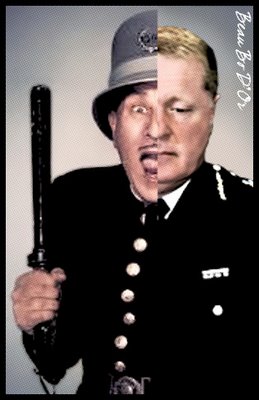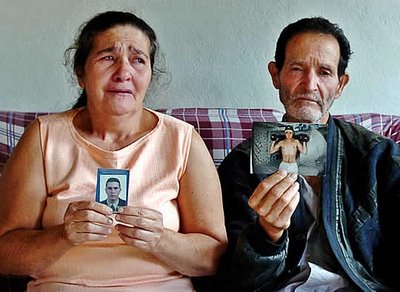de Menezes: Blair as mendacious and deluded as his namesake.
Finally then, a year and ten months it was first formally finished, we receive the IPCC investigation into the death of Jean Charles de Menezes (PDF).
What once would have been explosive and damning reading has been rendered, both by the leaks and the trial of the Met under health and safety legislation, into something almost familiar. It documents failures at all levels, from the officers conducting the surveillance on the morning all the way up to "Sir" Ian Blair himself.
The one thing that overwhelming sticks out from quickly speed-reading the entire document is that of the differing accounts between both the public witnesses of what happened on the tube train and that of the CO12 Special Branch officers and SO19 firearms officers, the first (section 13) who state the police made no mention of who they were when they entered the train, except from the CO12 officers stating "he's here", and the latter (section 18) who all claim that they shouted "police" or "armed police".
Similarly, Cressida Dick and the others inside "Room 1600" all maintain that de Menezes had been identified as Osman on a number of occasions, up to 5 in all. The CO12 officers (section 12) deny ever making a positive identification; indeed, the chronicle of events suggest that one officer decided it definitely wasn't Osman, while the others were uncertain, and thought that the surveillance should continue as a result. Although one managed to come to the conclusion that de Menezes had distinct "Mongolian eyes", there was never a definite positive given to Room 1600. Again, despite none of the surveillance team mentioning that the suspect was "jumpy" or "nervous", Room 1600 came to believe that de Menezes was agitated and "definitely their man." Dick and Detective Superintendent Boutcher requested that the surveillance team give a number on the scale of 1 to 10 on how sure they were that de Menezes was Osman (section 12.22), a request that the receiver, 'James', said was ridiculous, but said that when he had previously seen him over 15 minutes earlier he thought it was a "good possible". This was taken as "they believe it to be Osman."
Despite all the talk after the death of de Menezes of the police's use of "Operation Kratos", the shoot-to-kill policy on those suspected of being suicide bombers, it was never actually put into effect on the morning of the death. The report does go further into the background of Kratos (section 9) and how it came to be police policy, with there being little to no government input. The only real advice the police sought was that of the Treasury Counsel as to the legality of shooting to kill, which came to the conclusion that it was. One of the IPCC recommendations is that there should have been a public debate prior to the implementation of the policy, but that it wasn't thought necessary, or even worthy of discussion in parliament is an indictment of the secretive way of which the police continue to operate.
Even though Kratos was not in actual operation, de Menezes' fate may well have been sealed by the briefing delivered to the firearms officers at Nightingale Lane police station, which dropped everything but the actual shoot-to-kill policy itself into the mix. The individuals involved in the bombings were described as being "deadly and determined" and "up for it" (section 11.11); never was it mentioned that they might encounter those who were entirely innocent in the course of the day. The two officers who shot de Menezes, referred to as "Charlie 2" and "Charlie 12" in the report both said how they believed it was very likely that they would be asked to "intercept deadly and determined terrorist suicide bombers," in the words of Charlie 2 (section 18.21). Charlie 12 was more verbose (section 18.31):
‘We were possibly about to face subjects who had training and had attempted to commit atrocities on innocent human beings with complete disregard to their own lives. They had prepared devices in order to achieve this. There was a real tangible danger that if we didn’t act quickly and correctly there would be an extreme loss of life”.
Both felt as they entered the tube that de Menezes was about to detonate his explosives and they had no choice but to use deadly force, even though it had not been authorised by any officer. The report asked the Crown Prosecution Service to consider whether the actions of of Charlie 2 and 12 amounted to murder, given their justification for shooting de Menezes. (section 20.74). They decided against. Cressida Dick's abject failure to properly either know what was being sent to Room 1600 from the CO12 team, or to make clear to the SO19 team that she wanted de Menezes arrested and not shot, something she failed to make significantly clear, was of no help. One witness from within Room 1600, as had been leaked, claims that Dick added "at all costs." (section 12.36) Whether, if true, it would have made any difference we'll never know.
The report does possibly help clear up some of the initial eyewitness reports given to the media which were so horribly wrong. Many of the witnesses mistook "Ivor", the officer first on the scene and who grabbed hold of de Menezes for an Asian man, and with him also being thrown and a gun pointed at him, he could have easily been mistaken for the man who was shot.
There are a few more minor points in the report that are interesting or indicative of what already was happening on the scene in the aftermath; the pathologist who was on the scene by 13:33 on the 22nd of July was apparently briefed that de Menezes had vaulted the ticket barrier (section 14.16) and ran down the stairs before being shot after tripping, and included those "facts" in his report. It also notes how officers took statements from some of the witnesses inside nearby pubs while music was playing and with the news of what happened on the TV. One of the witnesses described how an officer tried to influence her statement (section 14.8):
“You have to be careful what you say in this sort of situation, or it will be just one more copper with a family losing his job or worse”.
It also shows how officers were allowed to draw up their statements on what happened together and come to a general consensus, whereas the witnesses were denied any opportunity to do just that.
This report really ought to have been the final nail in the coffin of Sir Ian Blair's term as head of the Met. The most damning condemnation is really reserved for him. The IPCC was not allowed any access to Stockwell tube station until the Monday, following Blair's order that the IPCC should be refused access, sent to the Home Office within an hour of the shooting. If we are to believe that Blair didn't know until the following morning that an innocent man was shot, it can't even be said he was trying to instigate a cover-up; he was simply opposed to the IPCC doing the job they was set up to do. Nick Hardwick, in his statement on the issuing of the report, made clear that the delay in the IPCC being able to investigate led directly to much of the "difficulty" that has faced the Met since then. The fact alone that Blair worsened the situation that the police has faced since the tragic death of de Menezes is reason alone for his resignation or sacking. That he presided over a police force that lied through its teeth, smeared de Menezes on a number of occasions and even now seems to deny that the failures were "systemic" makes him almost as mendacious and deluded as his namesake.
Labels: complete and utter fuck-up, Cressida Dick, injustice, IPCC, Jean Charles de Menezes, Metropolitan police, sir ian blair, Stockwell One



